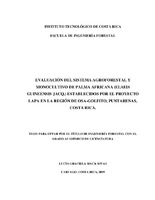Mostrar el registro sencillo del ítem
Evaluación del sistema agroforestal y monocultivo de palma africana (Elaeis guineensis jacq.) establecidos por el proyecto LAPA en la región de Osa-Golfito, Puntarenas, Costa Rica
| dc.contributor.advisor | Guevara-Bonilla, Mario | es |
| dc.contributor.author | Mack-Rivas, Lucía Graciela | |
| dc.date.accessioned | 2020-03-11T20:53:14Z | |
| dc.date.available | 2020-03-11T20:53:14Z | |
| dc.date.issued | 2019 | |
| dc.identifier.uri | https://hdl.handle.net/2238/11173 | |
| dc.description | Proyecto de Graduación (Licenciatura en Ingeniería Forestal) Instituto Tecnológico de Costa Rica, Escuela de Ingeniería Forestal, 2019. | es |
| dc.description.abstract | Actualmente, más del 60% del aceite de palma (Elaeis guineensis) producido en Costa Rica proviene de los cantones de Osa y Golfito. Buscando una estrategia de desarrollo sostenible, la Iniciativa Osa-Golfito (INOGO) desarrolló el Laboratorio Experimental de Palma Africana Sostenible (LAPA), un modelo productivo diversificado de E. guineensis con Cordia megalantha, Theobroma cacao y Musa spp. Este estudio tiene como objetivo caracterizar la cobertura vegetal, las propiedades químicas y físicas del suelo y generar una guía de recomendaciones para cinco parcelas de tres años de edad, establecidas por el proyecto LAPA. Se realizó un análisis FODA del diseño agroforestal y se determinó la mortalidad, altura, diámetro, calidad y el porcentaje de cobertura. Además, se determinaron las propiedades químicas y físicas del suelo. En Chacarita se encontró la mayor mortalidad de T. cacao y en La Guaria el crecimiento en altura y diámetro de C. megalantha fue estadísticamente diferente, siendo en esta menor. La altura de E. guineensis fue mayor en el sistema agroforestal que en el monocultivo en todas las parcelas. Las parcelas presentan un porcentaje de cobertura menor al 12% en el sistema agroforestal. Se identificaron los posibles factores limitantes del suelo para cada parcela. La menor velocidad de infiltración instantánea se registró en La Palma, y la mayor en Rancho Quemado. El mantenimiento y manejo son clave para garantizar el buen desarrollo de los cultivos. Al haber una apropiación adecuada por parte del productor se potencializa la posibililidad de generar productos de calidad, así obteniendo mejores ingresos económicos. | es |
| dc.description.abstract | Currently, more than 60% of the palm oil (Elaeis guineensis) produced in Costa Rica comes from the Osa-Golfito region. The Osa-Golfito Initiative (INOGO), developed the Experimental African Palm Laboratory (LAPA, by its spanish acronym), a diversified productivity model. This system consists on E. guineensis with Cordia megalantha, Theobroma cacao and Musa spp. The present study aims to characterize the vegetation and the physical and chemical soil properties in the three year old plots established by LAPA and generate recommendations. A SWOT analysis was done on the agroforestry system’s design. The mortality rate, height, diameter, quality and coverage percentage was determined for each plot, as well as the chemical and physical properties of the soil. Chacarita presented the highest mortality rate for T. cacao and La Guaria has a growth in height and diameter for C. megalantha statistically inferior than the rest of the plots. The plots present a percentage of coverage below 12%. The possible limiting factors in the soil were identified for each plot. The plot with the slowest infiltration velocity was La Palma and the fastest was found in Rancho Quemado. In diversified productive systems, management and maintenance are key factors to guarantee a good crop development. An adequate appropriation from the producer increases the possibility to generate quality products, therefore generating better income. | es |
| dc.language.iso | spa | es |
| dc.publisher | Instituto Tecnológico de Costa Rica | es |
| dc.rights | acceso abierto | es |
| dc.rights.uri | https://creativecommons.org/licenses/by-nc/4.0/ | * |
| dc.subject | Sistemas Agroforestales | es |
| dc.subject | Propiedades químicas | es |
| dc.subject | Propiedades físicas | es |
| dc.subject | Infiltración | es |
| dc.subject | Elaeis guineensis | es |
| dc.subject | Agroforestry systems | es |
| dc.subject | Physical properties | es |
| dc.subject | Chemical properties | es |
| dc.subject | Soil infiltration | es |
| dc.subject | Research Subject Categories::FORESTRY, AGRICULTURAL SCIENCES and LANDSCAPE PLANNING::Area technology::Forest engineering | es |
| dc.title | Evaluación del sistema agroforestal y monocultivo de palma africana (Elaeis guineensis jacq.) establecidos por el proyecto LAPA en la región de Osa-Golfito, Puntarenas, Costa Rica | es |
| dc.type | proyecto fin de carrera | es |



